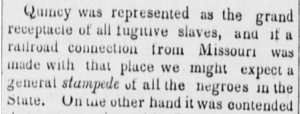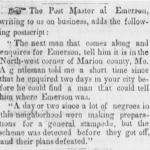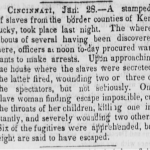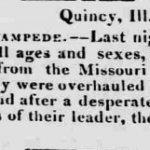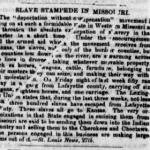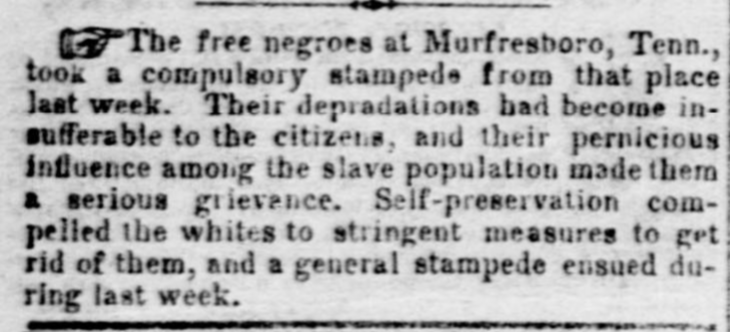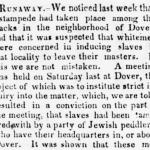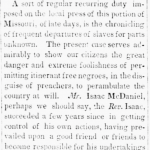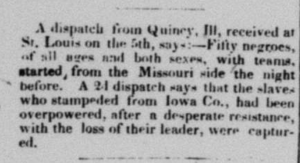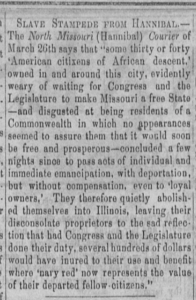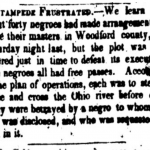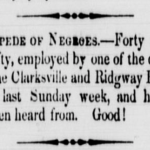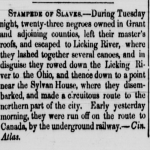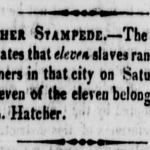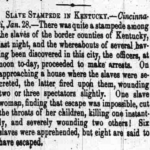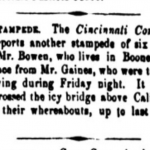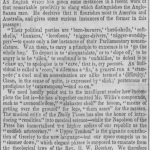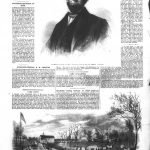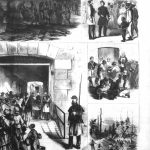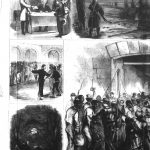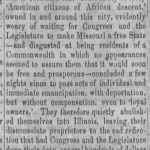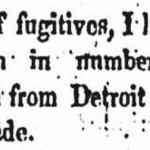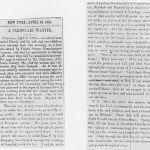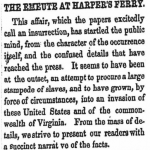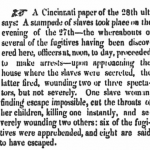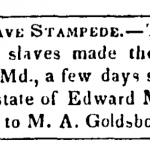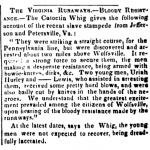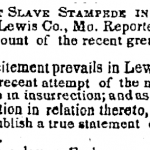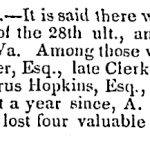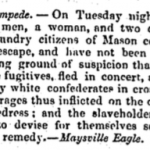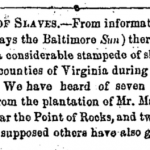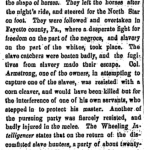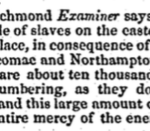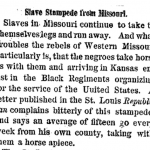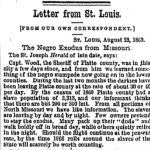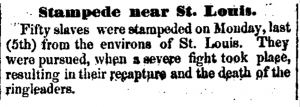
Plaquemine, LA Southern Sentinel, November 14, 1849 (Genealogy Bank Database)
Search Summary
- Search conducted by Cooper Wingert between December 12, 2018-January 9, 2019.
- Keywords: slave and stampede, including variants: “negro stampede,” “black stampede,” “general stampede” and “regular stampede.”
- Totals: Approximately 600 hits with concentrations of stampede attempts from Kentucky, Virginia, Maryland and Missouri
- NOTE: Because of extensive results, this search was limited to the above terms. We still need to attempt a wider array of search terms in GenealogyBank
Top Results
- In September 1852, the St. Louis Missouri Republican directed its readers’ attention to a “large reward for the apprehension of runaway negroes” involved in a “negro stampede” from St. Genevieve, Missouri. (“Negro Stampede-Large Reward,” St. Louis Daily Missouri Republican, September 11, 1852)
- In early November 1859, abolitionist papers cheered the “recent arrival at Detroit of a cargo of live freight consisting of twenty-six chattels all the way form Missouri.” (“The Detroit Underground Train,” New Lisbon, OH Anti-Slavery Bugle, November 12, 1859)
- A “negro stampede” in December 1859 included “thirty passengers, five from the vicinity of Richmond, Va., twelve from Kentucky and thirteen from Missouri.” The group arrived in Chicago, and later successfully journeyed to Canada. The Missouri fugitives “were sold to go down the river the very day they started,” and were prepared to fight off any pursuers. “A stalwart six-footer and a Sharpe’s rifle were the only guides.” (“Negro Stampede,” Raleigh North Carolina Standard, December 21, 1859)
- Multiple columns quoted a St. Genevieve, Missouri paper, which described a “stampede of negroes” from St. Genevieve County during the fall of 1862. The account detailed the decline of slavery throughout Missouri, including St. Louis, where “there were only 1400 slaves… two years ago, and the best judges now estimate that there are less than 500, and these principally old and decrepit home servants.” Overall, “negro property in Missouri has depreciated, and it is said to be nearly impossible to sell a slave anywhere in the country for one-fifth the ordinary price.” (“Slavery in Missouri,” New Orleans Daily Delta, November 13, 1862)
- In 1848, the Louisville Journal detailed an elaborate plan for a stampede of “about forty negroes” in Woodford County. Equipped with free passes, “each was to steal a horse and cross the Ohio river before day.” The stampede was “frustrated” when another slave revealed the plot. (“Stampede Frustrated,” Indianapolis Daily State Sentinel, October 21, 1848)
- A May 1850 column reported on a rumored slave insurrection near White Sulphur Springs, Virginia, suggesting instead that it was “simply a projected ‘stampede’ of slaves in the elegant frontier style of the day. These flights are becoming so frequent that they seem to be expected as a matter of course by the owners, nor does the offering of rewards seem usually to be attended with success.” (“Washington Correspondence,” Boston Recorder, May 23, 1850)
- Commenting on the frequency of stampedes, a Worcester, Massachusetts paper gleefully reported that “scarcely a day passes, on which we do not hear it stated, that there has been a stampede–a flight of slaves from the prison-house of Southern bondage…. These stampedes, from their inception to the issue of them, are the most heroic events in American history; and yet they are made the greatest of American political crimes.” (“Stampedes,” Worcester, MA Spy, November 17, 1852)
- In the aftermath of John Brown’s failed Harpers Ferry uprising, one abolitionist paper defended Brown’s plan to “run slaves, rather than free them by the slow process of legal and social reform.” “The Stampede is only a practical use of the Bill of Rights which God incorporated in the charter of human existence,” the paper argued. (New Lisbon, OH Anti-Slavery Bugle, November 26, 1859)
- A Charleston, South Carolina correspondent for the New York Tribune reported a stampede plot among the city’s slaves in the midst of the Secession Crisis in early 1861. “The idea which possessed the slaves seems to have been that the moment the first gun was fired in Charleston Harbor, they should make a stampede, taking with them all the property they could lay their hands upon.” He confidently predicted that this was “no singular case,” and that “the first gun fired against the United States Government will explode a powder magazine the vaults of which extend beneath the feet of the whole South.” (“From South Carolina,” New York Tribune, April 2, 1861)
- By the fall of 1863, newspapers in western Missouri were sounding the alarm about slave stampedes. “During the last two months the darkies have been leaving Platte county at the rate of about thirty or forty per day,” a paper in St. Joseph reported. “By the census of 1860 Platte county had a slave population of three thousand three hundred and thirteen, and our informant thinks that there are but two or three hundred left now. From all portions of North Missouri we have like information. The slaves are leaving by day and by night. Very few owners pretend to stay the exodus. Many pack up their duds and walk boldly off in broad day, while others quietly retire in the night.” (St. Joseph, Missouri Herald, quoted in “Slavery Passing Away in Missouri and Kentucky,” Worcester, MA Spy, September 9, 1863)
- The St. Louis Missouri Democrat reprinted columns from multiple papers to depict the mounting “negro exodus” from the state. Quoting the Kansas City Journal, the paper informed its readers of “some thirty or forty negroes” who left Clay County in western Missouri, bound for Kansas, “taking with them a quantity of stock…. The Emancipation Ordinance has made a perfect stampede among the negroes, who cannot draw nice distinctions…. The same process is going on all along the border, and Missouri will soon be rid of her slaves, in fact, if not in name. The barriers which fence in the slave system in this State are crumbling daily, and while our politicians are talking the negro is quietly acting, without any reference to statute books or ordinances.” (Kansas City Journal, quoted in “The Negro Exodus,” St. Louis Missouri Democrat, August 21, 1863)
- In late 1863, the Columbia Statesman in Boone County, Missouri, reported on a “stampede of negroes” to enlist in the U.S. Colored Troops. “Thirty negroes enlisted in Ray county last week. Ninety negro recruits were sent form St. Louis to Lexington…. thirty negroes left Pike county to enlist.” (Columbia Statesman, quoted in “Missouri Items,” St. Louis Daily Missouri Democrat, December 22, 1863)
Select Images
-
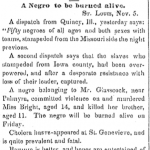
-
Cleveland Plain Dealer, November, 6, 1849
-
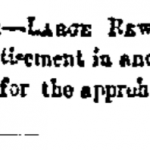
-
St. Louis Daily Missouri Republican, September 11, 1852
-
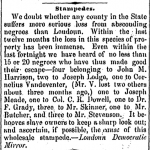
-
Alexandria VA Gazette, September 19, 1855
-
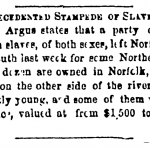
-
Cleveland Plain Dealer, December 5, 1855
-
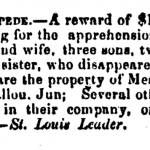
-
New Lisbon, OH Anti-Slavery Bugle, August 2, 1856
-
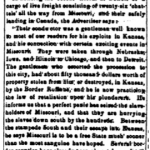
-
New Lisbon, OH Anti-Slavery Bugle, November 12, 1859
-
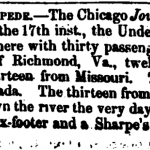
-
Raleigh North Carolina Standard, December 21, 1859
-
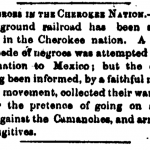
-
Athens, TN Post, January 20, 1860
-
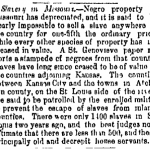
-
New Orleans Daily Delta, November 13, 1862
-
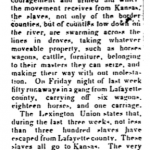
-
Bel Air, MD National American, May 22, 1863
-
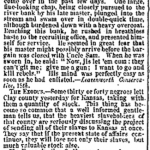
-
St. Louis Daily Missouri Democrat, August 21, 1863
-
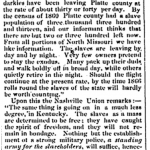
-
Worcester, MA Spy, September 9, 1863
General Notes
- Genealogy Bank is a subscription database.
- Although not part of the database’s coverage, the St. Joseph, Missouri Herald, the Columbia Statesman from Boone County and an unspecified St. Genevieve paper were quoted for their reporting on stampedes.
- After the passage of the controversial Fugitive Slave Law of 1850, the term was used to describe the movement of fugitive slaves residing in the Northern free states, who were reportedly “stampeding” to Canada to evade recapture under the stringent new law. A widely-reprinted report from Pittsburgh, Pennsylvania, suggested that there was a “general stampede” of the city’s fugitive slave population, including “many… who were never suspected of being fugitives until the passage of this bill.” (“Excitement among the Colored Population,” Baltimore Sun, September 25, 1850) Many Southern papers remarked on the “regular stampede” of “fugitive negroes” from “Pennsylvania, New York and other free states.” (“Arrest of a Slave,” Montgomery Alabama Journal, October 7, 1850) An Easton, Maryland newspaper even ran the headline “Fred. Douglass in Danger,” while reporting on the “general stampede” of “runaway negroes” from Pittsburgh. (“Fred. Douglass in Danger,” Easton, MD Star, October 15, 1850)
- Editors of the abolitionist Pennsylvania Freeman employed the term to mock pro-slavery arguments, satirically remarking that if slaves were so “enamored of the lash, the dungeon, the paddle, [and] the auction stand… one might imagine a general stampede of the fugitives in Canada and throughout the North, hurrying back to slavery.” (“Going Back to Slavery,” Pennsylvania Freeman, January 1, 1854)
- A Georgia paper used the term to describe violence against suspected abolitionists. “One out of the four [abolitionists] was caught and ridden on a rail, the rest saved themselves by a stampede.” (Columbus, GA Times, quoted in Woodville, MS Republican, October 22, 1850)
- The term was also used to describe the movement of free African-Americans. Reports circulated of a “compulsory stampede” of “free negroes” from Murfreesboro, Tennessee, compelled by white citizens who were concerned about “their pernicious influence among the slave population.” (Nashville Patriot, quoted in “Stampede of Free Negroes,” New York Herald, December 8, 1856)
- In August 1857, “over a dozen” slaves stampeded from Washington, using a religious camp meeting as an opportunity for escape. Obtaining permission to travel to the gathering in Montgomery County, Maryland, they instead “embraced the opportunity to seek a more permanent camp in Canada.” (Newark, NJ Centinel of Freedom, September 9, 1857)
- Stampedes could also include literal rail travel. An 1857 report noted a “stampede” of five slaves, who travelled using “horses and vehickles [sic]” from Hagerstown, Maryland across the border to Chambersburg, Pennsylvania, where they boarded the cars of the Cumberland Valley Railroad for Harrisburg. (“The Slave Stampede,” Easton, MD Star, June 2, 1857)
- In the south-west slaveholding states, the prospect of slave stampedes into Mexico troubled slaveholders. An Austin, Texas newspaper expressed concern about patrolling its enslaved population, worrying about a possible “insurrection, or a general negro stampede for Mexico.” (“Patrol,” Austin Texas State Gazette, July 22, 1854) Stampedes also occurred among slaves owned by members of the Cherokee Nation, in present-day Oklahoma. “A large stampede of negroes was attempted from the nation to Mexico,” a Tennessee paper reported in 1860, “but the chiefs having been informed, by a faithful negro, of the movement, collected their warriors, under the pretense of going on a war trail against the Camanches [sic], and arrested the fugitives.” (Athens, TN Post, January 20, 1860)
- The term was used to describe the escape of two Mississippi slaves owned by prominent Illinois senator Stephen Douglas. (“Stampede of two of Senator Douglas’ Slaves,” Wilmington Journal, September 17, 1858)
Most Relevant Coverage from Genealogy Bank Database
- MISSOURI: St. Louis Missouri Republican – 1849-1852 (Whig, pro-slavery)
- MISSOURI: St. Louis Weekly Pilot – 1855-1856
- MISSOURI: St. Louis Missouri Democrat – 1862-1863 (Democratic, pro-slavery)
- ILLINOIS: Quincy Whig – 1854 (Whig)
- MARYLAND: Easton Star – 1849-1857 (Democratic, pro-slavery)
- MASSACHUSETTS: Massachusetts Spy, Worcester, MA – 1847-1863 (Whig and Republican, anti-slavery)
- OHIO: Anti-Slavery Bugle, New Lisbon, OH – 1848-1860 (anti-slavery)

